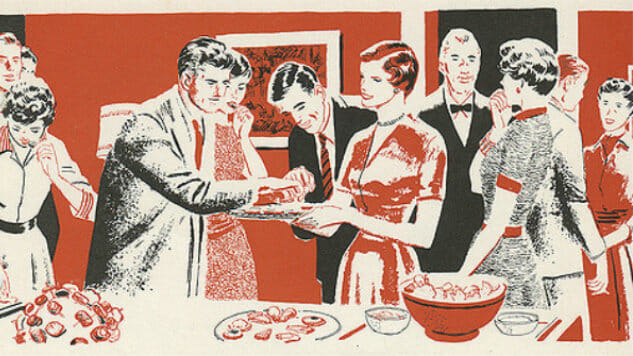Life-Changing Cookbooks: Betty Crocker’s New Picture Cookbook Taught Me American Food

Back in the 1970s, elementary school students didn’t get assigned any homework. Like most kids, I spent my afternoons flopped on the shag carpet watching re-runs of the The Brady Bunch and I Dream of Jeannie. If I was lucky, there were some stale Chips Ahoy to munch on. Unlike most kids, I liked to read my mom’s old cookbook while watching TV and eating snacks. There were only a few cookbooks on our maple Ethan Allen bookcase: two volumes full of Chinese food and Betty Crocker’s New Picture Cookbook. Of course, I was drawn to the strange and unfamiliar … Betty Crocker.
With her Mona Lisa expression, Betty looked out from her place at in the middle of the spine. She had the air of a home economics teacher: generally pleasant, but would probably shake her head in disappointment at the wrong setting of fork and spoon. The pastel Mondrian-inspired cover suggested that America’s favorite kitchen matron had gotten a groovy makeover. Published in 1961, the book was already somewhat dated by the time I was reading it. Glossy photo spreads were sprinkled throughout the chapters, featuring lurid Technicolor photos of petits fours the colors of Easter eggs, a sandwich loaf that looked like a tea sandwiches married to a layer cake, and shiny ham studded with pineapples and maraschino cherries. Everything was so shiny and color-saturated, carefully shaped and arranged.
The book would have been fairly new when my parents first arrived in America in the late 1960s. I imagine they bought it at Kmart in the South Dakota college town where they were graduate students, studying engineering and biology. Or perhaps it was a wedding gift from the older Swedish couple whose basement they rented. This was the America my parents landed in. It was the America I knew as a child, but where I never quite felt like I fully belonged. From visiting my friends’ houses, I glimpsed a peek that “real Americans” did not eat the way my family did. They did not huddle around an electric skillet that had been turned into a makeshift Chinese hot pot, swishing thin slices of beef into simmering broth. Their families did not await string-tied cardboard boxes from Taiwan filled with dried mushrooms and cans of pickled vegetables. Their mothers did not grow nameless greens in the backyard, which would be plucked and sautéed with whole cloves of garlic.
Elizabeth and Eileen — one sister a year older than me, one a year younger — lived down the street from my family. Their mother grew tidy rows of vegetables in the backyard. Before dinner, their mother would open the pantry door, revealing neat stacks of clear jars, filled with green beans, tomatoes, and corn. Sometimes, our games of Monopoly in the attic would be interrupted. “Would you like some fresh baked cookies?” she offered.
How could I attain this life complete with homemade cookies and a pantry full of pickled vegetables? Surely, Betty, with her competent smile and no-nonsense hairdo, would have the answers. I read the cookbook more than anyone else in our family. Occasionally, would my mother reach for it — to make a novelty like Swedish meatballs or Beef Stroganoff. Chipper notes at the beginning of each chapter offered tips on how to “serve with flair and seemed to assume the reader was female. But the few handwritten notes in the margins were in my father’s blocky draftsman’s print. “Too much sugar” was penciled in next to the ingredients for blueberry muffins.
By the time I was ten years old, I could follow the directions to bake Ethel’s sugar cookies. Unlike Mary’s sugar cookies on the next page, Ethel’s recipe could be dropped on the baking sheet — no rolling pin or cookie cutters necessary. In high school, I chose to make crepes for a French class project. I cracked open Betty Crocker’s New Picture Cookbook — its pages slightly more yellow and its spine a little more brittle — to find step-by-step directions for what I was certain was a pretty good replica of what would be served in Paris.